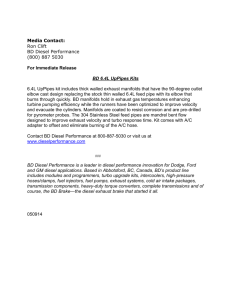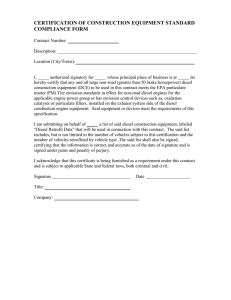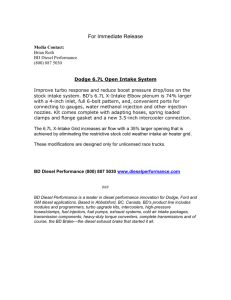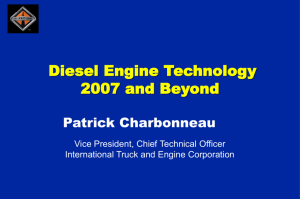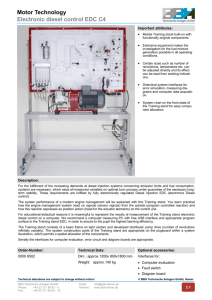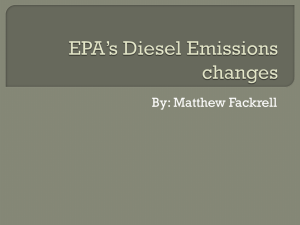2.61 Internal Combustion Engines MIT OpenCourseWare Spring 2008 rms of Use, visit:
advertisement
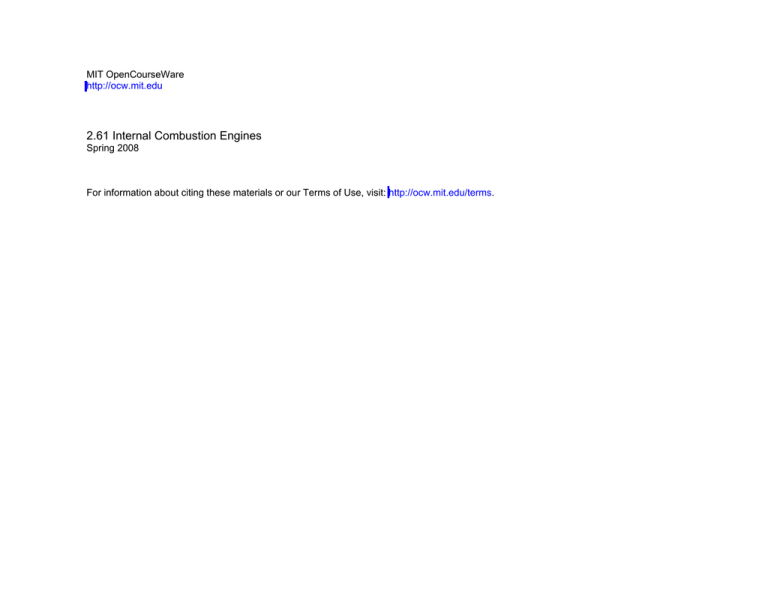
MIT OpenCourseWare http://ocw.mit.edu 2.61 Internal Combustion Engines Spring 2008 For information about citing these materials or our Terms of Use, visit: http://ocw.mit.edu/terms. Diesel Emissions and Control • • • • Diesel emissions Regulatory requirements Diesel emissions reduction Diesel exhaust gas after-treatment systems • Clean diesel fuels Diesel Emissions • CO – not significant until smoke-limit is reached ¾ Overall fuel lean ¾ higher CR favors oxidation • HC – not significant in terms of mass emission ¾ Crevice gas mostly air – Significant effects: ¾ Odor ¾ Toxics (HC absorbed in fine PM) – Mechanisms: ¾ Over-mixing, especially during light load ¾ Sag volume effect • NOx – very important ¾ No attractive lean NOx exhaust treatment yet • PM – very important ¾ submicron particles health effects Demonstration of over-mixing effect Diesel HC emission mechanisms Images removed due to copyright restrictions. Please see: Fig. 11-35 and 11-36 in Heywood, John B. Internal Combustion Engine Fundamentals. New York, NY: McGraw-Hill, 1988. Effect of nozzle sac vol. on HC emissions NOx mechanisms • NO: Extended Zeldovich mechanism N2 + O ↔ NO + N N + O2 ↔ NO + O N + OH↔ NO + H – Very temperature sensitive: favored at high temperature – Diffusion flame: locally high temperature – More severe than SI case because of higher CR • NO2 : high temperature equilibrium favors NO, but NO2 is formed due to quenching of the formation of NO by mixing with the excess air NO + HO2 ↔ NO2 + OH NO2 + O ↔ NO + O2 – Gets 10-20% of NO2 in NOx NOx formation in Diesel engines Images removed due to copyright restrictions. Please see: Fig. 11-15 and 11-16 in Heywood, John B. Internal Combustion Engine Fundamentals. New York, NY: McGraw-Hill, 1988. Normalized NO concentration from cylinder dumping experiment. Injection at 27o BTC. Note most of the NO is formed in the diffusion phase of burning NOx and NO emissions as a function of overall equivalence ratio Φ. Note that NO2 as a fraction of the NOx decreases with increase of Φ. Diesel combustion Image removed due to copyright restrictions. Please see: Flynn, Patrick F., et al. "Diesel Combustion: An Integrated View Combining Laser Diagnostics, Chemical Knetics, and Empirical Validation." SAE Journal of Engines 108 (March 1991): SP-1444. Particulate Matter (PM) • As exhaust emission: – visible smoke – collector of organic and inorganic materials from engine ¾Partially oxidized fuel; e.g. Polycyclic Aromatic Hydrocarbons (PAH) ¾Lubrication oil (has Zn, P, Cu etc. in it) – Sulfates (fuel sulfur oxidized to SO2, and then in atmosphere to SO3 which hydrates to sulfuric acid (acid rain) Particulate Matter • In the combustion process, PM formed initially as soot (mostly carbon) – partially oxidized fuel and lub oil condense on the particulates in the expansion, exhaust processes and outside the engine ¾PM has effective absorption surface area of 200 m2/g – Soluble Organic Fraction (SOF) 10-30% ¾(use dichloromethane as solvent) Elementary soot particle structure Image removed due to copyright restrictions. Please see: Fig. 11-41 in Heywood, John B. Internal Combustion Engine Fundamentals. New York, NY: McGraw-Hill, 1988. Source: Environmental Protection Agency, www.epa.gov. Dehydrogenation Oxidation Surface growth Dehydrogenation Oxidation Agglomeration Dehydrogenation Oxidation Adsorption, condensation In-cylinder Nucleation In atmosphere Time PM formation processes Diesel NOx/PM regulation 1 US 1990 EU 1991-93 PM(g/bhp-hr) Euro II (1998) Euro III(2000) 0.1 1994 1998 2004 Euro IV(2005) Euro V(2008) Euro VI (proposed-2013) 0.01 2007 0.1 1 10 NOx (g/bhp-hr) (Note: Other countries regulations are originally in terms of g/KW-hr) Diesel Emissions Reduction 1. Fuel injection: higher injection pressure; multiple pulses per cycle, injection rate shaping; improved injection timing control 2. Combustion chamber geometry and air motion optimization well matched to fuel injection system 3. Exhaust Gas Recycle (EGR) for NOx control ¾ Cooled for impact 4. Reduced oil consumption to reduce HC contribution to particulates 5. Exhaust treatment technology: NOx, PM 6. Cleaner fuels Effect of EGR 1.35 L single cylinder engine, Direct Injection, 4-stroke Images removed due to copyright restrictions. Please see: Uchida, Noboru, et al. "Combined Effects of EGR and Supercharging on Diesel Combustion and Emissions." SAE Journal of Engines 102 (March 1993): 930601. Split Injection Images removed due to copyright restrictions. Please see: Nehmer, D. A., and Reitz, R. D. "Measurement of the Effect of Injection Rate and Split Injections on Diesel Engine Soot and NOx Emissions." SAE Journal of Engines 103 (February 1994): 940668. PM Control Images removed due to copyright restrictions. Please see: Zelenka, P., et al. "Ways Toward the Clean Heavy-duty Diesel." SAE Journal of Engines 99 (February 1990): 900602. Post injection filter regeneration • Regeneration needs ~550oC • Normal diesel exhaust under city driving ~150-200oC • Need oxidation catalyst (CeO2) to lower light off temperature Image removed due to copyright restrictions. Please see: Fig. 8 in Salvat, O., et al. • Control engine torque "Passenger Car Serial Application of a Particulate Filter System on a Common • Minimized fuel penalty Rail Direct Injection Diesel Engine." SAE Journal of Fuels and Lubricants 109 (March 2000): SP-1497. Peugeot SAE 2000-01-0473 Increase exhaust gas temperature by injection of additional fuel pulse late in cycle. Diesel particulate filters use porous ceramics and catalyst to collect and burn the soot Please see slide 9 in Johnson, Tim. "Diesel Exhaust Emission Control." Environmental Monitoring, Evaluation, and Protection in New York: Linking Science and Policy, 2003. State-of-the Art SCR system has NO2 generation and oxidation catalyst to eliminate ammonia slip Image removed due to copyright restrictions. Please see p. 9 in "Recent Developments in Integrated Exhaust Emission Control Technologies Including Retrofit of Off-Road Diesel Vehicles." Manufacturers of Emissions Controls Association, February 3, 2000. Integrated DPF and NOx trap Image removed due to copyright restrictions. Please see: Fig. 3 in Nakatani, Koichiro, et al. "Simultaneous PM and NOx Reduction System for Diesel Engines." SAE Journal of Fuels and Lubricants 111 (March 2002): SP-1674. From Toyota SAE Paper 2002-01-0957 Clean Diesel Fuels 1. Lower sulfur levels ¾ 350 ppm → 15 ppm 2. 3. 4. 5. Lower percentage aromatics Oxygenated fuels Higher cetane number Narrower distillation range Diesel Emission Control Summary • Emission regulations present substantial challenge to Diesel engine system • Issues are: – performance and sfc penalty – cost – reliability – infra-structure support
